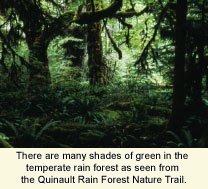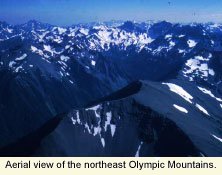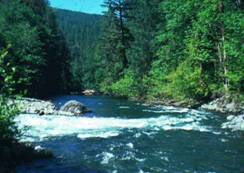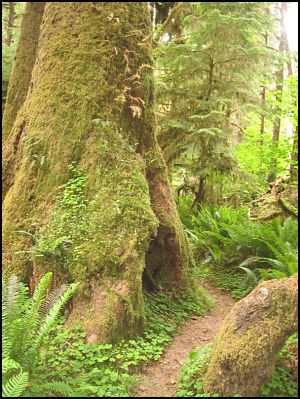Recreational Diversity
All of the traditional recreation activities are available on the Olympic National Forest. Opportunities for camping, picnicking, hiking, swimming, horseback riding, fishing, hunting, auto touring, backpacking, boating, and watching wildlife abound. And then there are some very unique opportunities such as scuba diving, oyster picking, and clam digging.
 The temperate rain forest is found on the western side of the Peninsula. The Quinault, Queets, Hoh, and Bogachiel drainages are the major temperate rain forest areas to visit. There are several nature trails that interpret the interesting features of the temperate rain forest. The Quinault Rain Forest Nature Trail on the south shore of Lake Quinault is an excellent example. This pleasant walk is a short 0.5 mile in length and colorful signs interpret this unique ecosystem. The Hoh Rain Forest Nature Trail in the Olympic National Park is another place to visit the Olympic's temperate rain forest.
The temperate rain forest is found on the western side of the Peninsula. The Quinault, Queets, Hoh, and Bogachiel drainages are the major temperate rain forest areas to visit. There are several nature trails that interpret the interesting features of the temperate rain forest. The Quinault Rain Forest Nature Trail on the south shore of Lake Quinault is an excellent example. This pleasant walk is a short 0.5 mile in length and colorful signs interpret this unique ecosystem. The Hoh Rain Forest Nature Trail in the Olympic National Park is another place to visit the Olympic's temperate rain forest.
 There are five large lowland lakes on the Olympic Peninsula. All five are over 1,000 acres in size. Lake Quinault, Wynoochee Lake, and Lake Cushman are in or adjacent to the Olympic National Forest, while Lake Ozette and Lake Crescent are in the Olympic National Park. Camping, picnicking, swimming, boating, fishing and boating opportunities are available at each lake. A state fishing license is required for fishing except at Lake Quinault where a Quinault Tribal fishing license is required. A license is not needed to fish at Lake Crescent and Ozette in the Olympic National Park, but National Park fishing regulations must be followed. All five lakes have boat ramp facilities available.
There are five large lowland lakes on the Olympic Peninsula. All five are over 1,000 acres in size. Lake Quinault, Wynoochee Lake, and Lake Cushman are in or adjacent to the Olympic National Forest, while Lake Ozette and Lake Crescent are in the Olympic National Park. Camping, picnicking, swimming, boating, fishing and boating opportunities are available at each lake. A state fishing license is required for fishing except at Lake Quinault where a Quinault Tribal fishing license is required. A license is not needed to fish at Lake Crescent and Ozette in the Olympic National Park, but National Park fishing regulations must be followed. All five lakes have boat ramp facilities available.
 The Olympic Mountains range from sea level to the summit of Mount Olympus at 7,965 feet elevation. This mountain range consists of many ridges extending out like spokes from the hub of a wheel. Most of the mountainous terrain on the Olympic Peninsula is within the Forest's or Park's Wildernesses. Wildlife, snow capped peaks, glaciers, cascading rivers, flowering meadows, and crystal clear lakes make this mountain range a very special place to visit. Backpacking, hiking, mountain climbing, hunting, and fishing are common activities in the Olympic National Forest's mountain ranges.
The Olympic Mountains range from sea level to the summit of Mount Olympus at 7,965 feet elevation. This mountain range consists of many ridges extending out like spokes from the hub of a wheel. Most of the mountainous terrain on the Olympic Peninsula is within the Forest's or Park's Wildernesses. Wildlife, snow capped peaks, glaciers, cascading rivers, flowering meadows, and crystal clear lakes make this mountain range a very special place to visit. Backpacking, hiking, mountain climbing, hunting, and fishing are common activities in the Olympic National Forest's mountain ranges.
 Salt water surrounds the Olympic Peninsula on three sides. Even the saltwater beaches on the Olympic Peninsula offer a diversity of landscape settings. The Pacific Ocean to the west, the Strait of Juan De Fuca to the north and the canals, bays and fingers of the Puget Sound to the east. Each offers different recreation opportunities and settings. For example, one can try surf fishing and beach combing for glass floats along the Pacific Ocean beaches; or walk the Dungeness Spit along the shore of the Strait of Juan de Fuca while keeping an eye out for many different kinds of water foul inhabiting or migrating through the unique Dungeness National Wildlife Refuge; or shucking oysters and digging for geoducks on the saltwater beaches of Puget Sound.
Salt water surrounds the Olympic Peninsula on three sides. Even the saltwater beaches on the Olympic Peninsula offer a diversity of landscape settings. The Pacific Ocean to the west, the Strait of Juan De Fuca to the north and the canals, bays and fingers of the Puget Sound to the east. Each offers different recreation opportunities and settings. For example, one can try surf fishing and beach combing for glass floats along the Pacific Ocean beaches; or walk the Dungeness Spit along the shore of the Strait of Juan de Fuca while keeping an eye out for many different kinds of water foul inhabiting or migrating through the unique Dungeness National Wildlife Refuge; or shucking oysters and digging for geoducks on the saltwater beaches of Puget Sound.
 Cascading streams and dense conifer forests radiate in all directions on the Olympic Peninsula. The Dosewallips, Duckabush, Hamma Hamma and South Fork Skokomish Rivers all flow to the Hood Canal on the eastern side of the Peninsula. The Satsop, Wynoochee, East Fork Humptulips and West Fork Humptulips Rivers drain to the Chehalis River or Grays Harbor to the South. The Quinault, Queets, Hoh, Bogachiel and Sol Duc Rivers flow to the Pacific Ocean along the west side of the Peninsula. The Elwa and Dungeness Rivers drain into the Strait of Juan de Fuca on the north side of the Peninsula. Each of these river settings offer excellent opportunities for auto touring, camping, picnicking, fishing and hiking.
Cascading streams and dense conifer forests radiate in all directions on the Olympic Peninsula. The Dosewallips, Duckabush, Hamma Hamma and South Fork Skokomish Rivers all flow to the Hood Canal on the eastern side of the Peninsula. The Satsop, Wynoochee, East Fork Humptulips and West Fork Humptulips Rivers drain to the Chehalis River or Grays Harbor to the South. The Quinault, Queets, Hoh, Bogachiel and Sol Duc Rivers flow to the Pacific Ocean along the west side of the Peninsula. The Elwa and Dungeness Rivers drain into the Strait of Juan de Fuca on the north side of the Peninsula. Each of these river settings offer excellent opportunities for auto touring, camping, picnicking, fishing and hiking.



